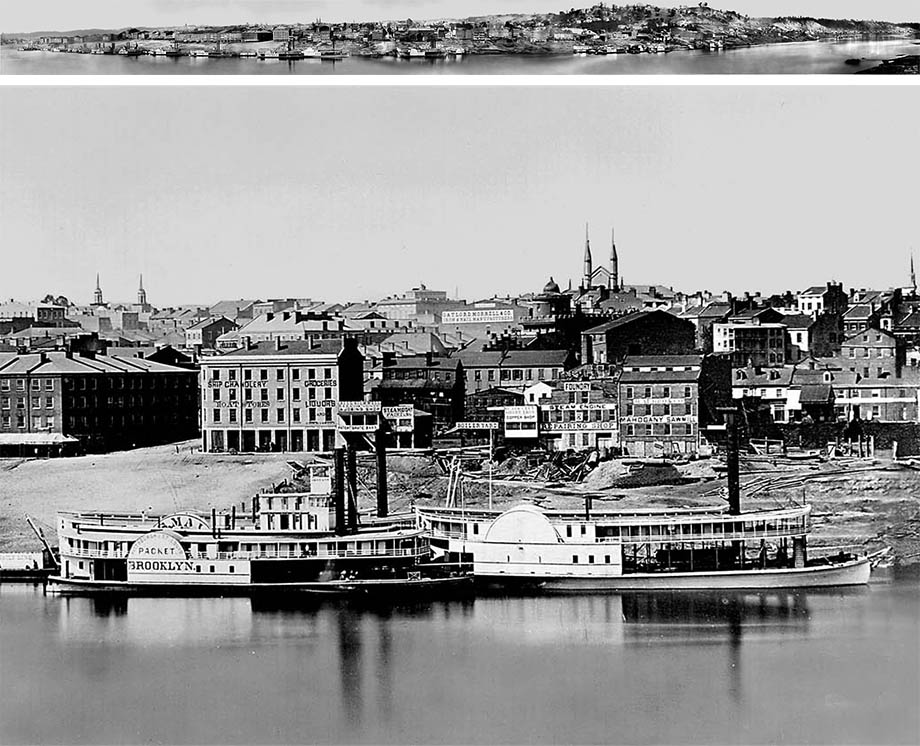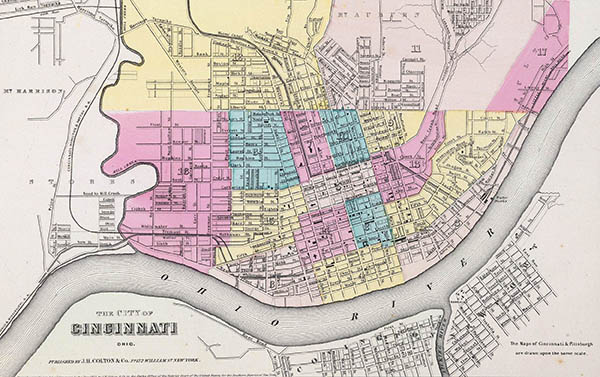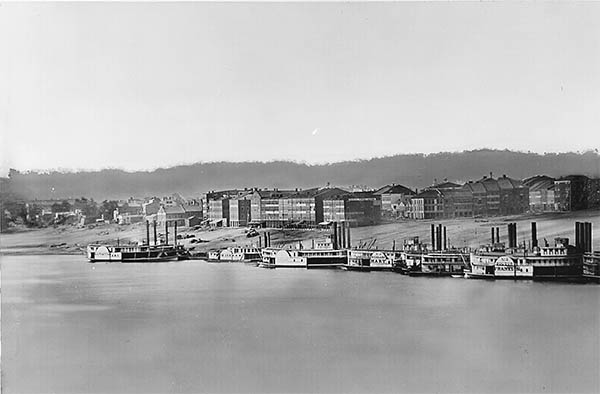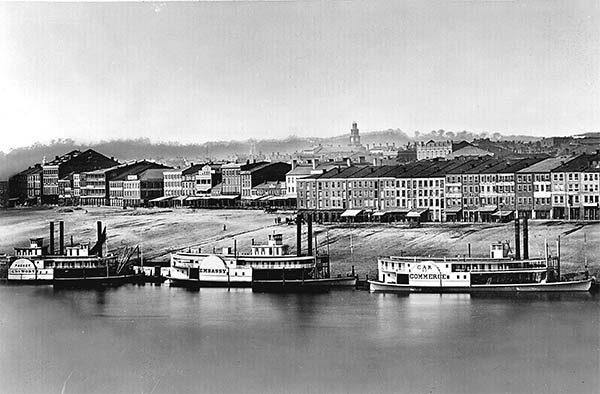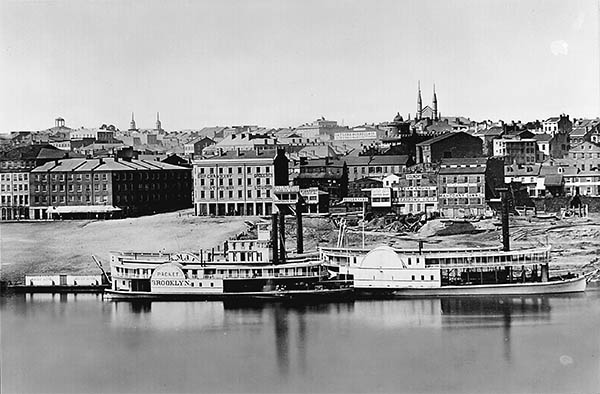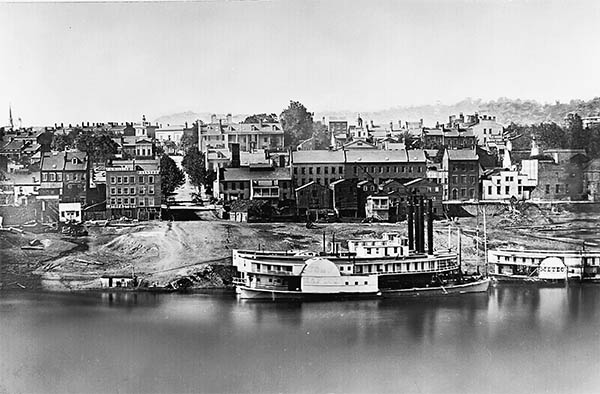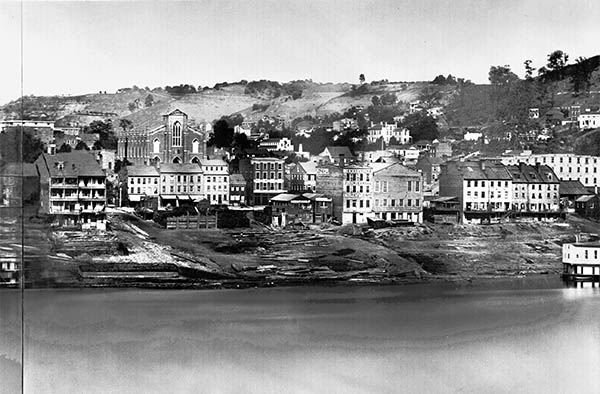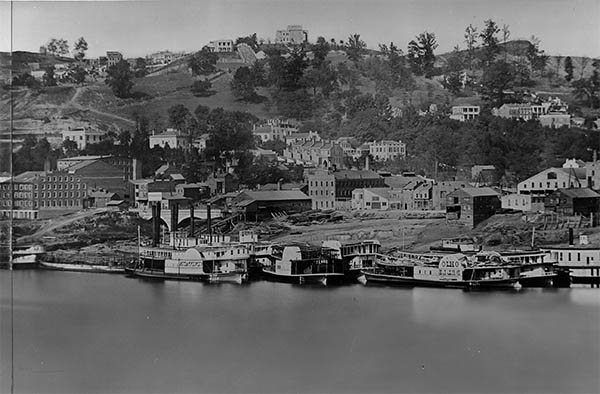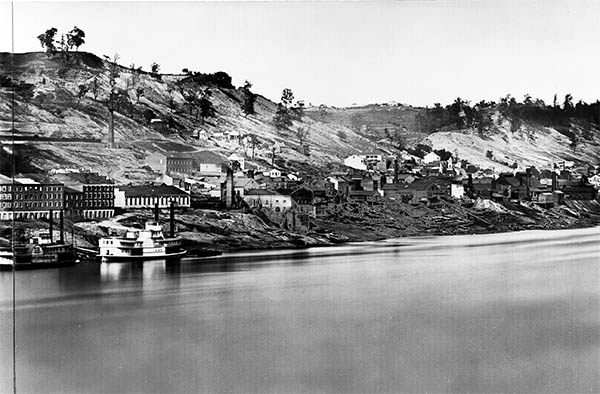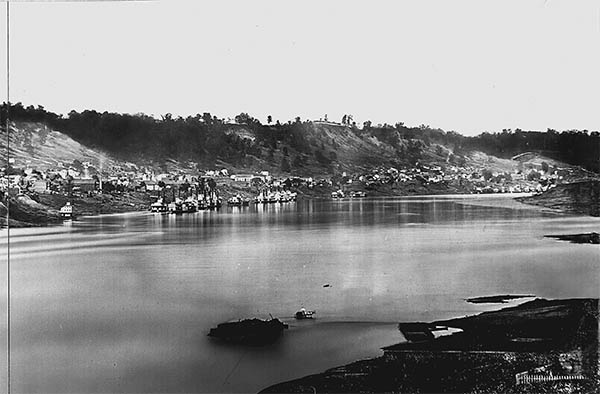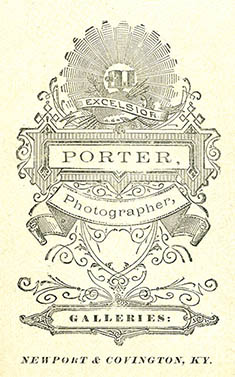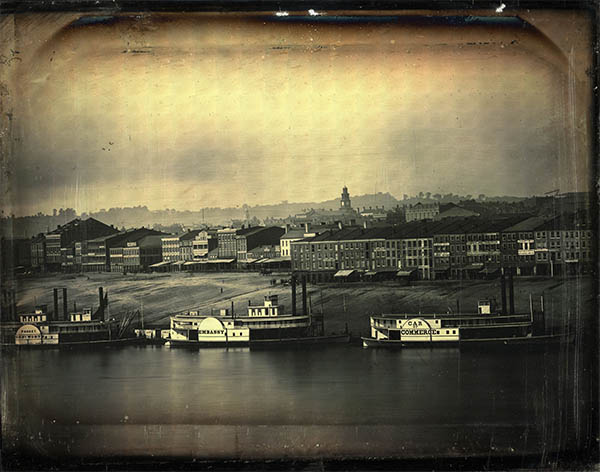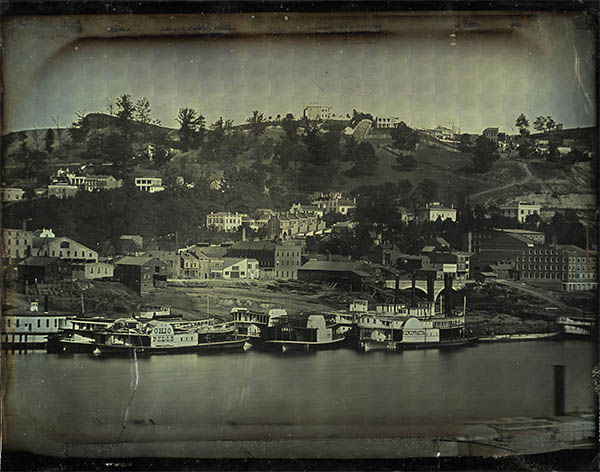The panorama and detail of plate 3. Public Library of Cincinnati and Hamilton County.1
Daguerreotype View of Cincinnati
Charles Fontayne and William Porter
This panoramic image of the Cincinnati riverfront, properly titled Daguerreotype View of Cincinnati. Taken from Newport, Ky, was reassembled from a later series of 8 × 10 film negatives.1 The original panorama consisted of eight full-plate (6.5 × 8.5") daguerreotypes and was taken in September 1848 by Porter and Fontayne (although most likely just by Porter). The 120° view shows a two mile stretch of the Cincinnati riverfront, from the Public Landing to the town of Fulton. Here is an 1855 map for reference:
Colton’s Atlas Of The World, plate 40, detail. Rumsey Collection
Cincinnati was first settled in 1788, incorporated in 1819 and by the middle of the nineteenth century was the sixth largest – and fastest growing – city in the US with a population of 115,000, half of whom were German immigrants. It was also the largest inland port (8000 arrivals a year) and the second largest inland shipyard in America.
The panorama is not only the first photograph of the Cincinnati waterfront but the earliest surviving panorama of any American city. Among other things it is the earliest photograph of inland steamboats, the earliest image of freed slaves and the first picture of a railroad terminal. It may very well be one of the most important American photographs ever taken.
Here are cropped, but otherwise un-retouched scans of the film negatives:
Plate 1: Western Public Landing
Plate 2: Public Landing, Cassilly’s row (r)
Plate 3
Plate 4: Lawrence Street (c)
Plate 5
Plate 6
Plate 7: Little Miami Railroad depot (l)
Plate 8: Towns of Fulton (l) and Columbia (r)
Charles H. Fontayne (1814–1901) and William Southgate Porter (1822–1889) were daguerreians with a studio in the Franklin Buildings in Baltimore around 1844–1845. Fontayne left to start a studio in Cincinnati and Porter became sole owner of the Baltimore Gallery in May 1846. Porter experimented with panoramic images and on 22 May 1848 he produced a seven-plate daguerreotype of the Fairmount Water Works in Philadelphia:
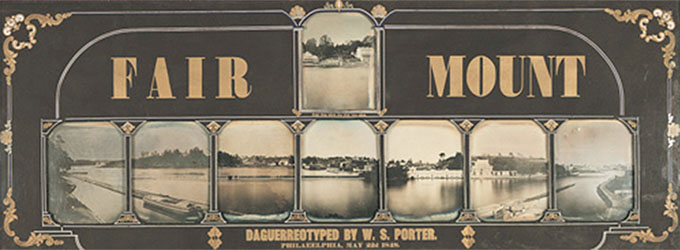
Porter soon rejoined Fontayne at his 30 West Fourth Street studio and on Sunday, 24 Sept 1848 they set up their camera on a rooftop in Newport, Kentucky and took the Cincinnati panorama.2
The plates, elaborately matted and framed in mahogany won first prize at the Franklin Institute in Philadelphia and at the Maryland Institutes’ Exhibition of the Mechanical and Fine Art in 1849. It was even among the American daguerreotypes sent to the Crystal Palace Exhibition in London in 1851.

Fontayne and Porters’ partnership dissolved in the mid 1850s. In 1855 Fontayne was advertising life-size photographs at a new gallery in Cincinnati. In 1856 he moved to Cleveland and assisted James F. Ryder in making “solar enlargements.” He later invented a high-speed photo printer3 and in 1858 moved to New York City but within the year was back in Cincinnati. Finally, in 1891, he is listed as residing in Passaic, New Jersey. Porter, on the other hand, mostly stayed put. He continued to maintain his studio and gallery in Cincinnati, at various addresses, until 1873, when he moved his studio across the river to Covington, Kentucky where he is listed in directories as late as 1887:
CDV back, ca.1880s
After Fontayne left Cincinnati the panorama remained with Porter. The Cincinnati Times Star reported that it was displayed at James Landy’s gallery in 1887 but otherwise it remained unseen until it was loaned to the Public Library of Cincinnati and Hamilton County in 1912. The panorama, still in it’s original frame and was hung in the old Main Library for years.
In 1947 the new Library director Carl Vitz bought the plates from Porter's son as part of a public relations campaign for a new main library. He had them professionally photographed for a wall mural but otherwise hid them from view - they were now simply too fragile for public display.
The panorama first came to the attention of conservation experts during a rare 1985 exhibition at the Cincinnati Art Museum. It was clear that work was desperately needed but it still took another 20 years before the plates were sent to the George Eastman House for restoration.
The Eastman team disassembled the plates but found that chemical or mechanical cleaning was too risky so instead they sealed the plates in an argon-filled case. As a record they created high-res (16–32 ×) digital images using a stereo microscope. Researchers at the University of Rochester then developed several novel image analysis techniques.4 The idea is if you couldn't restore the fragile original then you could restore a digital copy of it.
Mosaics from the micrographic scans. Courtesy PLCHC
To capture all of the detail present in the original image the Eastman conservators photographed more than 6300 1040 × 1344 pixel tiles (7.07 GB). The result showed the astonishing resolution of the daguerreotypes – from Fontayne and Porter’s vantage point some 1500 ft away they were able to photograph details down to individual spokes in wheels or bricks in buildings.
Nearly terminal detail from plate 4. Courtesy PLCHC
Finally on 21 May 2011, after 60 years in storage and several years of restoration the Library put the panorama back on public display in an interactive exhibit.5
1. All of these images are courtesy of the Public Library of Cincinnati and Hamilton County and used by permission. Special thanks to John Reusing and Patricia van Skaik of the Library.
The 8 × 10 film negatives, possibly copies of the set taken by the Langley Photo Co. in the 1940s, were obtained by my dad, the camera collector/historian in the 1980s. The seamless panorama was created in Photoshop.
2. Based on the boats and buildings, the low water level, the foliage, the shadows, as well as the apparent inactivity on the riverfront, and corroborated by historical boat manifests and construction records, water level data and local weather reports, Carl Vitz and Capt. Frederick Way suggest that the panorama was taken in the early afternoon of Sunday, 24 Sept 1848 from York Street in Newport. See: Vitz, Carl. “A Cincinnati Daguerreotype.” Address to the Cincinnati Literary Club, 20 Oct 1947 (online).
The clock tower of the Second Presbyterian Church, less than 1 mm dia. on the original plate, had eluded Vitz and Way but was finally legible after the Eastman/Rochester restoration. It read 1:55 pm:
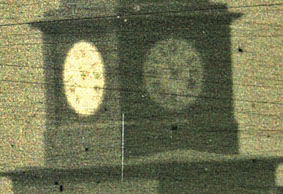
3. US patent 25,540. Photographic Printing-Machine. Charles Fontayne. 20 September 1859.
5. See: Tang, X., Ardis, P.A., et. al. “Digital Analysis and Restoration of Daguerreotypes” 2010. Proceedings of the SPIE (online).
5. For high-res zoomable versions of all eight plates, as well as historical annotations, see the PLCHC’s Cincinnati Panorama of 1848. The University of Rochester presents four complete plates as zoomable high-res images here. A large version of the entire panorama from film negatives is available at the Ohio Memory Project.
19 Dec 2008, updated 12 Jun 2013 ‧ Photography
The City of Cincinnati:
